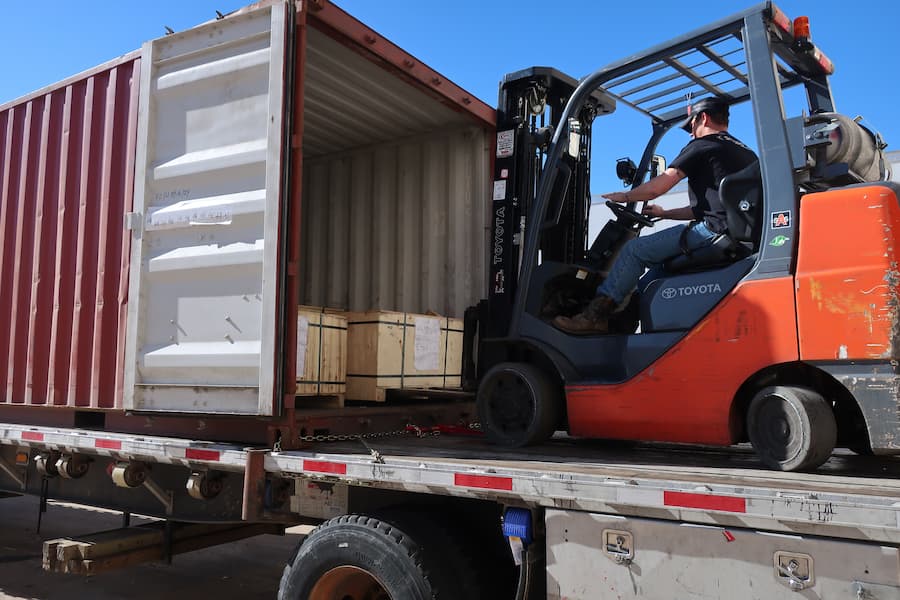You’re late for an important meeting. The freeway is jammed—you’ll never make it on time. If you could just get off the freeway, maybe you could take the side streets…Then you see a space between two semis, just enough to get into the right lane for that off-ramp just ahead.
Don’t do it. It could be the last move you make.
“Car drivers see a space between trucks, and they jump in,” said truck driver Ryan Kitchel in a recent interview with The Washington Post. “They don’t realize that’s our stopping lane. We need that space.”
And if trucks can’t stop, well, your odds aren’t good. Your car probably weighs 3,000 – 4,000 pounds. A typical 18-wheeler can weigh as much as 80,000 pounds. That weight makes it very difficult for them to stop quickly. If you are both traveling at 65 mph in ideal conditions, your car would able to stop in about 316 feet (around the length of a football field), but a fully loaded semi would take almost twice as long.
And it’s not just the weight that makes it difficult for big rigs to stop quickly. Most semis use air brakes, which have a lag time. Once a driver hits the brakes, the air pressure has to build up before the brakes are applied.
Other built-in factors can make it difficult for truck drivers to avoid errant cars. They don’t have rearview mirrors and so they rely heavily on their side mirrors (and sometimes cameras). But that restricted view combined with the truck’s size and height creates several large blind spots for semi drivers.
Truck drivers also can’t swerve as easily once they do see an encroaching car since the high center of gravity of a loaded truck makes it more likely to tip over. And that high center of gravity coupled with the truck’s length means truckers need to make wide turns, a maneuver that auto drivers sometimes fail to recognize until it’s too late.
Truck Accident Causes
Car-truck accidents are more likely to cause injury or death than other vehicular accidents. That fact is widely accepted, but less well-known is the fact that it’s usually not the truck driver’s fault. In-depth crash studies suggest that the auto driver is at fault in around three-quarters of fatal accidents (the fault becomes more evenly spread between trucks and cars as the crash severity decreases).
Another surprise is that weather doesn’t play as big as a factor as you’d think. According to the Federal Motor Carrier Safety Administration (FMCSA), 70.7% of fatal crashes involving large trucks occurred in clear weather and 14.5% in cloudy weather. Rain was present in just 6.2% of the accidents; snow and fog in less than 2%.
Night driving (6 pm- 6 am) isn’t much of a factor either: The majority of accidents happen during the day. Time of the week does matter, though, with weekday accidents responsible for 84 percent of fatal crashes and 88 percent of non-fatal ones.
Setting matters, too. The FMCSA reported that “Approximately 61 percent of all fatal crashes involving large trucks occurred in rural areas, 27 percent occurred on Interstate highways, and 15 percent fell into both categories by occurring on rural Interstate highways.”*
And though blowouts may be scary, they are not a major cause of fatal accidents, contributing only 1 percent of the time for both truck and auto drivers. The major cause of car-truck accidents? Driver-related factors. That’s good news in a way because it means that most accidents can be avoided.
* FMCSA 2016 (most recent data)
How to Avoid Accidents
Don’t speed.
“’Speeding of Any Kind” is the most frequent driver-related factor for drivers of both vehicle types;” according to the FMCSA. “Distraction/Inattention” was the second most common factor for large truck drivers, and “Impairment (Fatigue, Alcohol, Illness, etc.)” was the second most common for passenger vehicle drivers.”
Don’t drive distracted.
It seems we can’t get away from our phones—but we really should when we’re on the road. Distracted driving accidents are on the rise, especially among young people. “Every day, I see people using their phones while they are driving on the highway and in the city,” says truck driver Steve Smalley, America’s Road Team Captain. “In five seconds, a car travels the full length of a football field at 55 miles per hour. Just think about all the things that could go on while texting ‘hello’ to someone.”
Those two tips obviously apply to driving in general, but there are also specific defensive tactics you can use when sharing the road with semis:
Avoid drivers’ blind spots.
If you’re traveling in one of the “No Zones” below, your car is as good as invisible to the driver of the truck.
Not sure if you’re in a blind spot? Use this tip: If you can see the driver’s face in the truck’s side mirrors, the driver can see you. Bonus: by staying out of the “No Zones” you’re giving the truck more space with which to maneuver and stop.
Pass trucks carefully—and never on the right.
See that big blind spot above, on the right side of the truck? That’s one of the reasons you’re supposed to pass on the left. Also, make a full pass—one that puts you in front of the truck, not along its side where the driver can’t see you. And be careful when gauging passing distance: You’ll not only need more time to pass the longer vehicle but more distance when merging in front of the truck (a truck’s front “No Zone” is nearly 20 feet). A good rule of thumb: It’s safe to pull in front of a semi when you can see both its headlights in your rearview mirror.
Be aware of turning trucks (especially when they’re turning right).
Not only do they need to make wide turns, there’s that huge blind spot on their right to deal with. Motorcyclists and bicyclist should never slip in on the right side of a truck stopped at an intersection for the same reasons.
Don’t crowd intersections.
Stop behind the lines marked on the street. They’re there for a reason, and by stopping closer to the intersection you’re putting yourself and other drivers at risk.
Watch for trucks backing up.
Backover accidents are not as common as highway accidents, but they can be just as deadly, especially for pedestrians and cyclists. Remember, drivers can’t see behind their trucks. If a truck is backing up, stay safely out of its way.
Safety Counts
As experienced experts in the freight broker business, we understand the need for safety and make sure that loads are transported with the utmost care for the products, the truck drivers, and other drivers on the road. At Next Exit Logistics, we earn the trust of our clients with efficiency, transparency, and security. In addition, we understand how to handle freight services for unusual, oversize, or overweight shipments and are certified to arrange the shipment of hazardous materials. To learn more about our services, call Next Exit Logistics at 866-624-2661 or contact us via email.




